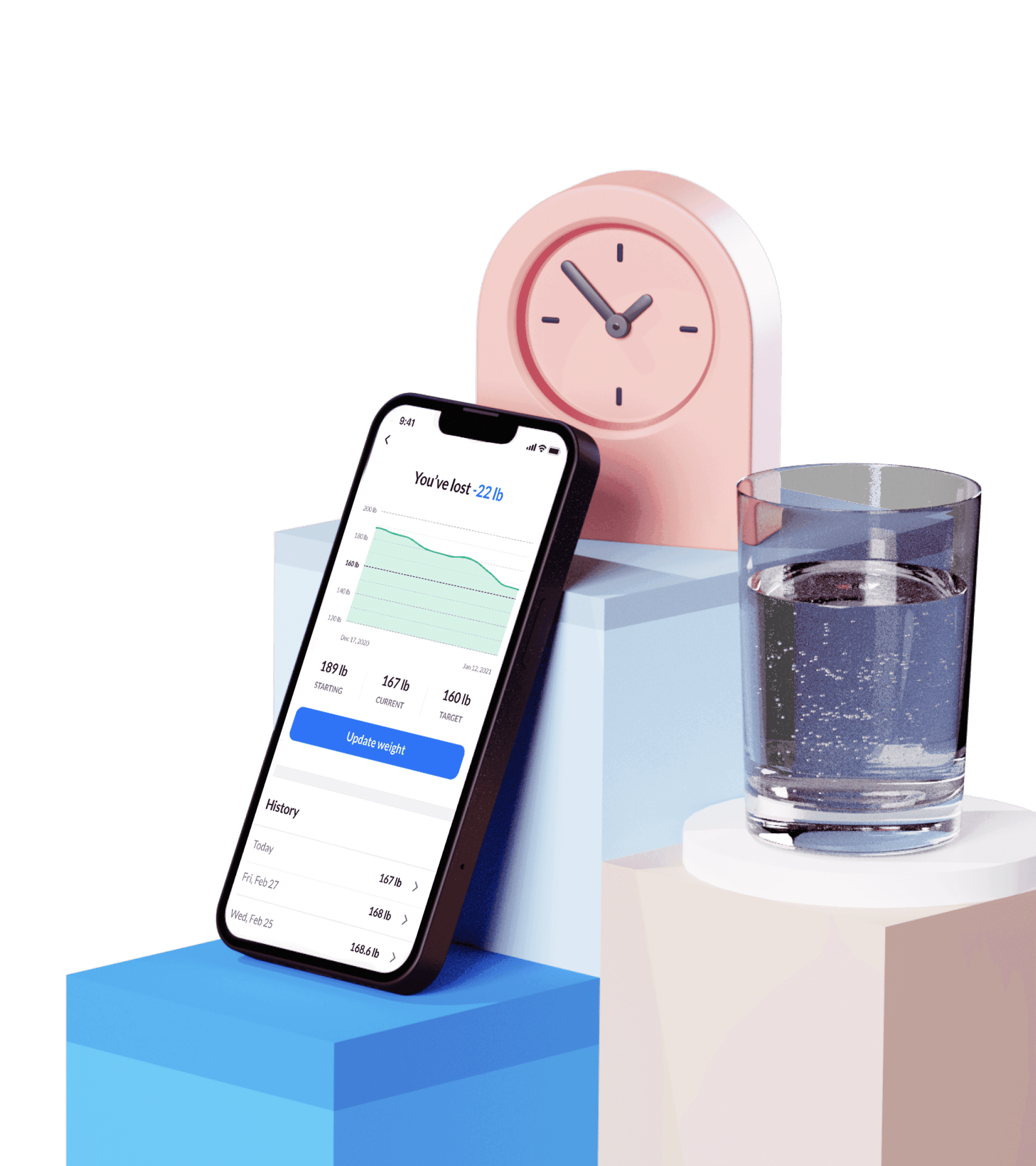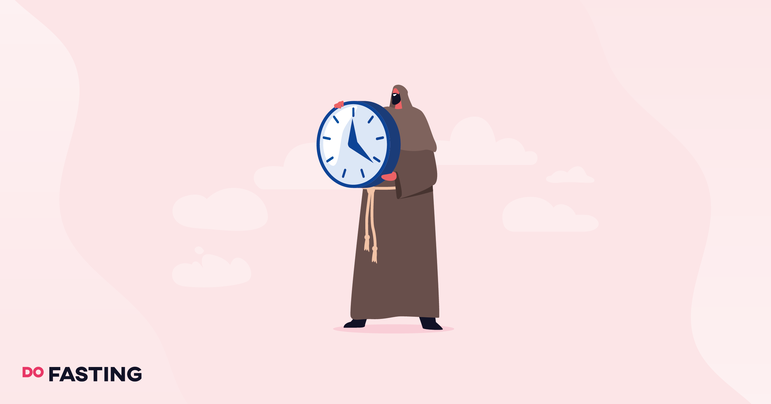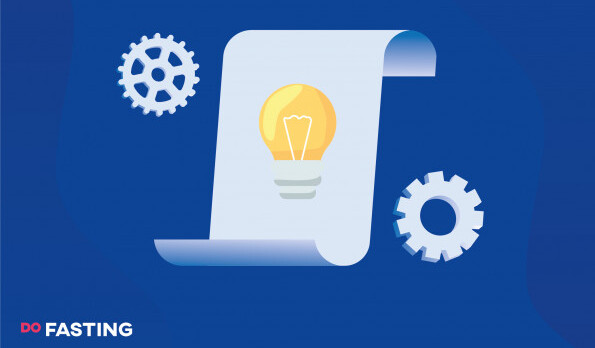Contents
What is a 36 hour fast?
The 36-hour fast, also known as the Monk Fast, is a method of intermittent fasting that involves extended fasting over a period of 36 hours. This particular fasting plan should only be attempted by advanced fasting users!
Like all intermittent fasting methods, it helps people to lose weight by reducing their calorie intake and inducing a metabolic state in the body, called ketosis, which promotes fat loss.
The Monk fast comes with many other benefits too on top of its ability to help reduce body weight.
A Monk fast diet can be suited to many different lifestyle types but starting the fast on a Monday evening, by eating your evening meal and then fasting through until Wednesday morning is a common schedule.
During the 36-hour fast, certain calorie-free beverages, like water, unsweetened tea, and unsweetened coffee, can be consumed, though no other food is allowed.
It may be practiced each week to boost weight loss, fat burning, and overall health.
Take a
1-minute quiz
and discover how much weight you can lose with DoFasting!

4 Steps on How to Do the 36-Hour Fast Safely
When it comes to an intermittent fasting regimen, it is essential that you are following the method safely to ensure you remain in good health while significantly reducing your calorie intake.
Below are a number of ways you can practice the Monk fast safely.
-
Work your way up to the extended fast
Starting off, your body may find prolonged fasting too difficult, to begin with. Build up to the Monk fast, it is best to practice other intermittent fasting methods first to get your body a little more used to this periodic fasting.
There are many intermittent fasting methods to try that can ease your body into a state where it can handle extended fasting periods. These include the 12:12 method, the 14:10 method, the 16:8 method, the Warrior Diet, Alternate-Day fasting, OMAD (One Meal A Day), and the 24-hour fast.
Begin with a less challenging fast and build on it each week to reduce side effects experienced during the fasting period, like headaches and hunger pangs.
-
Get a fasting app that can track extended fasts and consumed drinks at the same time
When you are beginning your Monk Fast, you will find that tracking your zero-calorie beverage intake as well as calories intake throughout the rest of the week can help you to stay on track with your fasting.
A fasting app can help to ensure you drink adequate amounts during your fast and eat a normal amount of calories on your eating days.
The DoFasting app can provide an easy way to track your fasting as well as offer you a ton of recipes to try out once you have finished your fast.
If you are still determining whether a paid fasting app is worth the money, check out how DoFasting stands against competitors like Simple App, which offers free plans.
Take a
1-minute quiz
and discover how much weight you can lose with DoFasting!

-
Keep consuming water, tea, and coffee to stay full and hydrated
It is important on your fasting days to stay properly hydrated. This means drinking enough water and calorie-free beverages throughout the period to keep your hydration levels up.
In addition to providing hydration, consuming water can help to curb hunger cravings throughout the fast.
Drinking unsweetened coffee and tea will also provide you with caffeine which helps to boost focus and concentration which could be lacking when eating fewer calories.
-
Plan the meal to break the 36-hour fast in advance
The meal that breaks your fast needs to be carefully planned in advance. This is for two reasons. The first is so that you don’t binge eat after so long without food and shock your body.
The second is that your digestive system hasn’t had to digest in a long time and so a meal filled with gentle foods is required to ease the system back into digesting solid food.
Plan this meal before you even begin your fast.
5 Health Benefits of Following the 36-Hour Fast
There are many health-promoting benefits of following a Monk Fast once a week. We have summarized the 36-hour fast benefits below.
-
Increased weight loss
Weight loss is the main benefit of all intermittent fasting methods. Intermittent fasting promotes weight loss in a number of ways.
The first way weight loss is promoted is through the calorie restriction imposed on the body by time-restricted consumption. Due to the hours spent fasting, you eat at a natural calorie restriction for at least part of your week.
Reducing calorie consumption is the main goal of any weight loss diet as a calorie deficit allows your body to burn more calories than it takes in.
The second way the Monk fast promotes weight loss is through the boost in metabolism that is frequently seen through any kind of short-term fasting.
A boost in metabolism helps the body to burn off excess fat and build lean body mass.
Finally, during a period of fasting that exceeds 12 hours, most people’s bodies will enter a metabolic state called ketosis. This state pushes the body to burn fat in place of blood sugar for fuel, helping to reduce body fat.
-
Induces autophagy
Autophagy, or self-eating, is a natural process in the body that allows for the elimination of dysfunctional cells and the regeneration of newer, healthier cells.
Increased autophagy is beneficial to the body in a number of ways. These include increased longevity, reduced risk of cancer, protection from certain liver diseases, and prevention of the development of neurodegenerative diseases.
Autophagy is triggered by calorie restriction and short-term fasting.
-
Improves blood sugar levels
Intermittent fasting is beneficial to the regulation of high blood sugar levels.
Due to prolonged periods of fasting where food intake, and therefore sugar, is kept to a minimum, blood sugar doesn’t spike as frequently, helping the body to respond in a healthier way to sugar levels in the blood.
As the fasting period leads to lower blood sugar, it is important you ensure that you remain hydrated and if you experience extremely low blood sugar, you take action to counteract these symptoms.
-
Helps with cardiovascular health
Intermittent fasting, and the Monk Fast, in particular, is known to improve cardiovascular health, helping to prevent diseases of the heart and blood vessels, like heart disease.
Fasting helps to improve markers of poor heart health, like high blood pressure.
Studies suggest that short-term fasting may improve levels of LDL cholesterol in the blood. Reducing levels of this kind of cholesterol can contribute to good heart health and reduce the risk of developing cardiovascular conditions like heart disease.
-
May prevent type 2 Diabetes
Along with the regulation of levels of sugar in the blood, the Monk Fast may also aid in the management and prevention of the development of type 2 diabetes.
With more control over blood sugar comes a healthier response to it, meaning insulin levels and type 2 diabetes can be made more manageable.
Additionally, a better response to blood glucose can prevent insulin resistance, helping to stop people from developing this kind of diabetes in the first place.
Can You Have Bone Broth During the 36-Hour Fast?
Bone broth is a debated subject in the world of fasting. While some say it can be drunk during the fasting window, it does technically break the fast if you consume 50kcal or more and so considerations need to be made about its consumption.
Dr. Fung recommends drinking bone broth during a fast to replenish lost electrolytes and to avoid dehydration during the prolonged period of fasting as well as helping to curve hunger pangs.
Bone broth also contains lots of amino acids, including glycine, which helps to support healthy insulin levels during the fast.
What to Eat After 36-Hour Fast?
When it comes to breaking the fast, it is important that you begin with a small meal full of easily digestible foods. This is to ease your digestive system back into action after a long period of inactivity.
In addition, if you eat a large meal immediately after a fast, you may then go on to binge eat and begin to follow unhealthy patterns of eating.
Foods to eat when breaking a 36-hour fast
We have already discussed some of the virtues of bone broth, and it is these benefits that make it a good way to break the fast as well as a possible food to consume during the fast. Check out some fantastic bone broth recipes here.
Other gentle and easily digestible foods you could have in your post-fast meal include fermented foods, healthy fats like extra virgin olive oil or coconut oil, protein to prevent muscle loss, vegetables to replenish nutrients, and whole grains.
Though vegetables and whole grains are considered good foods to eat after breaking the fast, you may want to eat them after the other foods on this list to allow the body to readjust before adding lots of fiber back to your diet.
Foods to avoid when breaking the 36-hour fast
There are plenty of nutritious and healthy foods that you can consume when you start eating again, but there are also lots that you should avoid.
These foods tend to have little nutritional value and are heavily refined, making them empty calories, or they are high in sugar which can cause a massive blood sugar spike after a fast. They include:
- Alcohol
- Candy
- Dairy products
- Fast or processed foods
- Fruit juice
- Pressed meat
- Red meat
- Refined grains
- Soda pop
- Sugary foods
Are There Any Side Effects of Following the 36-Hour Fast?
Fasting for 36-hours can be hard on the body. As one of the longer periods of fasting found in intermittent fasting diets, there are a few side effects you may experience when following this diet.
Though these side effects are not unique to the Monk Fast specifically, they may be amplified by the extremely long periods of fasting.
Side effects include:
- Hunger cravings – A long while without food will obviously cause you to feel hungry. You can get around this by taking appetite suppressants if your hunger cravings are not manageable.
- Bad breath
- Fatigue and low energy – Drinking caffeine may counteract this for a short while.
- Dehydration – This is a real danger of the Monk Fast which is why it is important that you drink plenty of water during fasting times.
- Sleep pattern disturbance – If you already suffer from sleep issues, you should avoid intermittent fasting.
- Irritability – An empty stomach tends to cause changes in our mood.
- Digestive issues
- Binge eating afterward – It is important that your first meal after a fast does not encourage binge eating so avoid refined foods that can be addictive.
Though there are side effects, the health and weight loss benefits from the body remaining in a fat-burning mode for 36 hours are worth it if you can get these side effects under control.
Who Should Not Consider Doing the 36-Hour Fast at All?
There are a number of different people who should not try the Monk Fast or should only use this method when under medical supervision. These people include:
- Pregnant people or people who breastfeeding
- Anyone who has a condition that will be exacerbated by calorie restrictions and fasting
- People who are taking certain medications that must be taken with food
- Anyone with a history of eating disorders
- There is some research that suggests fasting may affect women differently than men and so you may want to do your own research if you are intending to begin intermittent fasting as a woman
Conclusion
The Monk Fast involves consuming nothing but calorie-free beverages for 36 hours at a time. Research suggests that this method of fasting can help to boost weight loss and promote burning fat stores for fuel rather than blood glucose.
Fasting comes with other health-promoting benefits and can be done safely by following our few tips listed here.
There are some side effects to the Monk fast but most can be kept to a minimum and will reduce as your body adjusts to the fast.
Some people should not try intermittent fasting but it appears a safe diet for most other people.
Take a
1-minute quiz
and discover how much weight you can lose with DoFasting!

Leave a Reply
See how DoFasting will improve your life
Find out what works for you with this 60-sec quiz approved by our experts and get your personal revolutionary fasting assistant.
Start the Quiz















2 Comments
Having read this I thought it was extremely informative. I appreciate you spending some time and effort to put this short article together. I once again find myself personally spending way too much time both reading and commenting. But so what, it was still worth it!
Thank you very much.